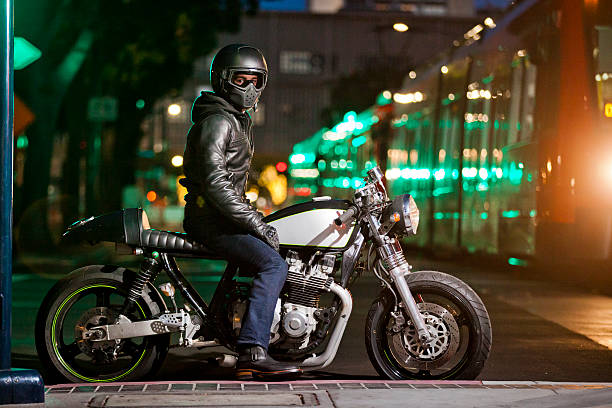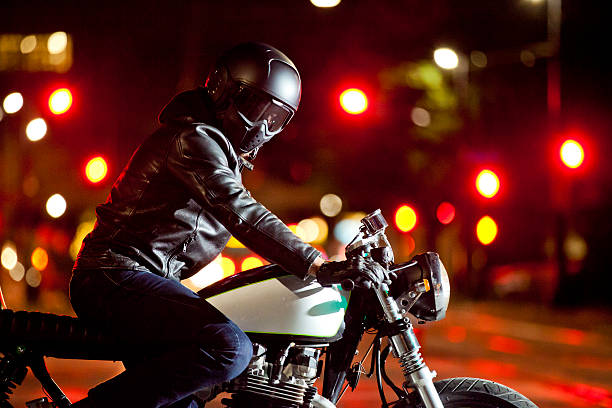Leather Vest Bikers’ Iconic Look
A biker in vest symbolizes independence, revolt, and rugged individualism. American society has shaped this unique style, which has become a global symbol. To appreciate its appeal, one must study the leather vest’s history, cultural effect, and evolution in motorcycling and beyond.

Leather vests became associated with motorcycle culture after World War II. Returning troops used motorcycles to express themselves and relive the war’s camaraderie and exhilaration. An initial practical decision for durability and safety, the leather vest quickly became a canvas of identity. With patches, pins, and club colors, these vests offered stories of loyalty, adventure, and disobedience.
Motorcycle clubs became prominent in the 1950s and 60s, and the leather vest became a biker staple. Movies like “The Wild One” featuring Marlon Brando helped popularize the rebellious biker during this time. The leather vest, worn over a white t-shirt or denim jacket, symbolized freedom and non-conformity, breaking conventional dress rules.
Biker culture changed over the decades, as did the biker vest. Vest styles changed in the 1970s and 1980s. Biker vests with studs, fringe, and unique artwork became increasingly elaborate. With the growth of women in motorcycling, the vest’s design and connotation changed.
Leather vests have cultural significance beyond motorcycling. Many subcultures and movements have adapted it, changing its meaning and style. The late 70s and 80s punk movement used vests with band logos and anti-establishment slogans to fight against the mainstream. The vest became the ‘battle jacket’ in heavy metal, covered in band patches and metal iconography.
In modern fashion, the biker vest is essential. High fashion designers have used its rugged appeal. This vest’s integration into mainstream fashion shows its longevity as a helpful item turned statement piece.
The leather vest’s psychological attraction is its capacity to convey identity and affiliation. Many motorcyclists consider their vest part of their image. It represents a lifestyle of independence, camaraderie, and the broad road. These vests are unique storybooks of their wearers’ journeys because their patches and symbols often signify major milestones, personal views, and affiliations.
In addition to its cultural value, the leather vest is functional. It protects bikers from weather and road hazards. Long rides are more accessible with pockets and compartments for essentials. The vest now uses modern fabrics and technologies for enhanced protection and comfort.
Leather vests influence biker activities and gatherings. Creative vest contests and presentations are common at rallies and bike fairs. The vests’ aesthetic appeal and community ideals are celebrated at these events.
Finally, the leather vest is a powerful emblem in motorcycling and beyond. A garment is more than simply clothing; it symbolizes pride, self-expression, and a link across cultures and generations. From utilitarian roots to fashion icon status, the leather vest represents bikers’ freedom and open-road attitude. It shows how the motorbike culture continues to captivate and inspire.

How Leather Vests Became Biker Symbols
The image of a biker in a vest is rugged, free-spirited, and representative of a subculture that values its identity. This picture, firmly established in popular culture, represents a long, complex history that defines motorcycle culture. The leather vest’s growth from a functional garment to a cultural icon reflects biker culture’s ideals, history, and ethos.
Practicality drove motorcycling apparel in the beginning. Riders needed protective, road-worthy clothes. Leather was appropriate due to its durability and weather resistance. Early riders favored the vest because it balanced protection and mobility.
The leather vest became a cultural emblem after World War II. Motorcycle clubs formed by combat veterans provided consolation and friendship, developing the biker subculture. These early motorcyclists used the leather vest as a canvas to represent their identity and solidarity.
These vests came to have club patches, ornate designs, and other symbols, each conveying a tale or indicating a rank or achievement. The leather vest symbolized devotion, camaraderie, and defiance against society as bikers customized them.
Motorcycle clubs became prominent in the 1950s and 60s, making the leather vest iconic. Although sensationalized, media portrayals popularized the leather-clad biker. Films like “The Wild One” and “Easy Rider” popularized the leather vest while celebrating and demonizing bikers.
Over the years, the vest’s meaning changed. In the 1970s and 80s, motorcycle subcultures adopted the leather vest, giving it its design and connotation. The punk movement reinterpreted the leather vest by adding spikes, painted graphics, and a band logo.
Women’s motorcycling participation also shaped the vest. The leather vest, once a symbol of a male subculture, began to represent women motorcyclists. Its significance was enhanced by custom vests for ladies, often with unique, creative, and symbolic aspects.
Leather vests also evolved into mainstream fashion. Due to its rugged appeal and symbolic potency, designers began including vests, blending subculture and high fashion. This crossover has promoted the vest’s legendary status in biker culture.
The leather vest is fundamental to biker identity today.
& culture. Motorcycle rallies and festivals often feature a variety of vests decorated to symbolize the wearer’s travels and associations. Each vest represents a biker’s life, achievements, and ideals, making it as unique as the wearer.
Leather vests are still practical as they were in the early days of motorcycling. Modern vests combine history with technology with safety gear, reflective fabrics, and multifunctional pockets. This mix of old and new emphasizes the vest’s biker appeal.
Leather vests remain important in motorcycle groups. Vests with club colors and patches show devotion and belonging. These hallowed vests represent the club’s history and character. Earning a club vest and patches is a rite of passage that shows community dedication and respect.
The leather vest affects more than bikers. The vest’s symbolism of revolt and independence has inspired artists, singers, and filmmakers. This cultural mixing shows the vest’s symbolism of individualism and self-expression.

Besides its cultural significance, the leather vest has influenced bikers’ social dynamics. The clothing unites bikers across socioeconomic lines. The vest symbolizes togetherness and community involvement at biker-organized charity rides and events.
The evolution of the leather vest reflects shifting attitudes in motorcycle culture. Once considered a criminal symbol, the vest has gained legitimacy, representing the diverse and often misunderstood motorcycle community. Bikers’ attempts to refute prejudices and promote their culture have contributed to this change.
In conclusion, the leather vest is more than apparel. An outfit with a long history, it represents biker beliefs and customs. Its transformation from a functional tool to a cultural emblem mirrors biker culture’s rise from the margins to the mainstream. The leather vest symbolizes freedom, camaraderie, and the open road, demonstrating the biker community’s resilience.






Leave a Reply